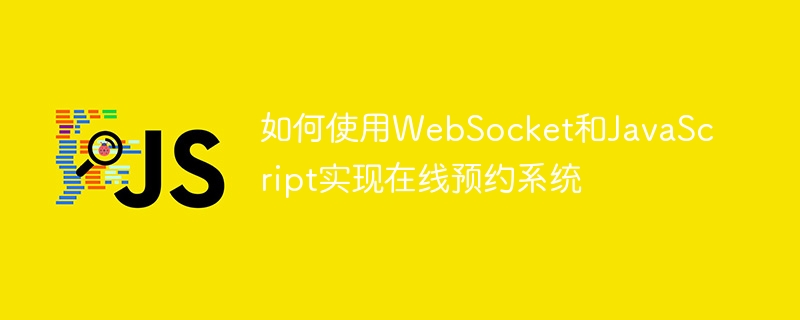所属分类:web前端开发

如何使用WebSocket和JavaScript实现在线预约系统
在当今数字化的时代,越来越多的业务和服务都需要提供在线预约功能。而实现一个高效、实时的在线预约系统是至关重要的。本文将介绍如何使用WebSocket和JavaScript来实现一个在线预约系统,并提供具体的代码示例。
一、什么是WebSocket
WebSocket是一种在单个TCP连接上进行全双工通信的协议。它可以在浏览器和服务器之间建立一个持久性的连接,实现实时通信。相比传统的HTTP请求,WebSocket能够更快速地实现数据的发送和接收。
二、示例需求分析
我们假设我们正在开发一个健身房的在线预约系统。用户可以通过网站选择合适的时间段进行预约,系统会及时反馈给用户所选时间段的状态。
基于上述需求,我们可以将系统分为两个角色:客户端和服务器。客户端提供用户可操作的界面,而服务器负责处理用户的预约请求,同时将实时的预约状态推送给客户端。
三、客户端实现
new WebSocket(url)来建立到服务器的WebSocket连接。其中url为服务端的WebSocket地址。const socket = new WebSocket("ws://localhost:8080/ws");
socket.addEventListener("open", (event) => {
console.log("WebSocket连接已建立。");
});
socket.addEventListener("message", (event) => {
const message = JSON.parse(event.data);
console.log("收到消息:", message);
});function bookTimeslot(timeslot) {
const message = {
action: "book",
timeslot: timeslot
};
socket.send(JSON.stringify(message));
}function updateTimeslotStatus(timeslot, status) {
const element = document.getElementById(timeslot);
element.innerHTML = status;
}<!DOCTYPE html>
<html>
<head>
<script>
const socket = new WebSocket("ws://localhost:8080/ws");
socket.addEventListener("open", (event) => {
console.log("WebSocket连接已建立。");
});
socket.addEventListener("message", (event) => {
const message = JSON.parse(event.data);
console.log("收到消息:", message);
updateTimeslotStatus(message.timeslot, message.status);
});
function bookTimeslot(timeslot) {
const message = {
action: "book",
timeslot: timeslot
};
socket.send(JSON.stringify(message));
}
function updateTimeslotStatus(timeslot, status) {
const element = document.getElementById(timeslot);
element.innerHTML = status;
}
</script>
</head>
<body>
<h1>健身房预约系统</h1>
<h2>可预约时间段:</h2>
<ul>
<li id="timeslot1"><button onclick="bookTimeslot('timeslot1')">8:00-9:00</button></li>
<li id="timeslot2"><button onclick="bookTimeslot('timeslot2')">9:00-10:00</button></li>
<li id="timeslot3"><button onclick="bookTimeslot('timeslot3')">10:00-11:00</button></li>
</ul>
</body>
</html>四、服务器实现
在服务器端,我们需要处理客户端发送的预约请求,并根据系统状态更新预约状态。同时,服务器还需要将新的预约状态发送给客户端。
ws模块来创建WebSocket服务器。const WebSocket = require('ws');
const wss = new WebSocket.Server({ port: 8080 });
const timeslots = {
timeslot1: "可预约",
timeslot2: "可预约",
timeslot3: "可预约"
};
wss.on('connection', (ws) => {
ws.on('message', (message) => {
const data = JSON.parse(message);
if (data.action === "book") {
if (timeslots[data.timeslot] === "可预约") {
timeslots[data.timeslot] = "已预约";
ws.send(JSON.stringify({
timeslot: data.timeslot,
status: timeslots[data.timeslot]
}));
}
}
});
ws.send(JSON.stringify(timeslots));
});const WebSocket = require('ws');
const wss = new WebSocket.Server({ port: 8080 });
const timeslots = {
timeslot1: "可预约",
timeslot2: "可预约",
timeslot3: "可预约"
};
wss.on('connection', (ws) => {
ws.on('message', (message) => {
const data = JSON.parse(message);
if (data.action === "book") {
if (timeslots[data.timeslot] === "可预约") {
timeslots[data.timeslot] = "已预约";
ws.send(JSON.stringify({
timeslot: data.timeslot,
status: timeslots[data.timeslot]
}));
}
}
});
ws.send(JSON.stringify(timeslots));
});五、总结
本文介绍了如何使用WebSocket和JavaScript来实现一个在线预约系统,并提供了完整的客户端和服务器端代码示例。通过使用WebSocket实现实时通信,我们能够实现更加高效、实时的在线预约系统。它也可以应用在其他需要实时通信的场景中。希望本文对你的项目开发有所帮助!